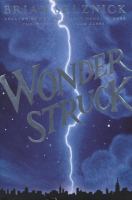
Selznick follows his Caldecott-winning The Invention of Hugo Cabret with another illustrated novel that should cement his reputation as one of the most innovative storytellers at work today. Ben and Rose are both hearing-impaired. He is 12 in 1977; she is the same age 50 years earlier. Selznick tells their story in prose and pictures beginning with Ben, living (unhappily) with his aunt and uncle, 83 steps from the Minnesota lake cabin he shared with his librarian mother until her death in a car accident three months earlier. He has never met his father, but has reason to believe he may live in New York. As in Hugo Cabret, a significant part of the story is told in sequential illustrations, most of which depict the even unhappier Rose, whose movie star mother has remarried, leaving her daughter with her ex-husband in New Jersey. Both children run away to Manhattan seeking something from their respective absent parents. It takes several hundred pages and a big chunk of exposition to connect these two strands, but they converge in an emotionally satisfying way. Selznick masterfully uses pencil and paper like a camera, starting a sequence with a wide shot and zooming in on details on successive pages. Key scenes occur when the runaways find themselves in one of Manhattan's storied museums, and with one character named Jamie, and Rose's surname being Kincaid, it's impossible not to think of E.L. Konigsburg's From the Mixed-up Files of Mrs. Basil E. Frankweiler, to which Selznick tips his hat in an author's note. Like that Newbery winner, Selznick's story has the makings of a kid-pleasing classic. Ages 9-up. (Sept.) (c) Copyright PWxyz, LLC. All rights reserved.
Gr 4-8-Using the format he so brilliantly introduced in The Invention of Hugo Cabret (Scholastic, 2007), Selznick tells two parallel stories. The first, taking place in 1977, is told through words. Ben Wilson lives in Gunflint, MN. His mother has just died, and he doesn't know the whereabouts of his father. Disaster ensues when Ben is struck by lightning and loses the hearing in his one good ear. He runs away from his aunt and uncle and goes in search of his father. Parallel to Ben's story, and told through illustrations, is the story of Rose, a deaf child who lives in Hoboken, NJ, in 1927, with her overbearing father. She lives in a room that feels more like a prison, where she keeps a scrapbook of her silent-film star mother and builds models of New York City. Both Ben and Rose escape to New York and are drawn to the American Museum of Natural History. It is there that they find the connections they are seeking. The way that the stories of Ben and Rose echo one another, and then finally connect, is a thing of wonder to behold. The dual text/illustration format is not a gimmick when used to tell the right stories; the combination provides an emotional experience that neither the words nor the illustrations could achieve on their own.-Tim Wadham, St. Louis County Library, MO (c) Copyright 2011. Library Journals LLC, a wholly owned subsidiary of Media Source, Inc. No redistribution permitted.
*Starred Review* Opening Selznick's new book is like opening a cabinet of wonders the early museum display case filled with a nearly infinite variety of amazing things that is so central to this story. Following the Caldecott Medal-winning The Invention of Hugo Cabret (2007), Selznick offers another visual narrative, one that feels even better suited to his inventive style. The beautifully crafted structure includes two stories set 50 years apart. The first, set in 1977, is told in text and follows Ben, who is grieving the sudden loss of his mother when he stumbles upon clues that point to his father's identity. The second, told entirely in richly shaded pencil drawings, opens in 1927 as a young girl, Rose, gazes at a newspaper clipping. Rose is deaf, and Ben also loses his hearing, during a lightning strike. Both lonely children run away to New York City, and their parallel stories echo and reflect each other through nuanced details, which lead like a treasure map to a conjoined, deeply satisfying conclusion. Selznick plays with a plethora of interwoven themes, including deafness and silence, the ability to see and value the world, family, and the interconnectedness of life. Although the book is hefty, at more than 600 pages, the pace is nevertheless brisk, and the kid-appealing mystery propels the story. With appreciative nods to museums, libraries, and E. L. Konigsburg, Wonderstruck is a gift for the eye, mind, and heart.--Rutan, Lynn Copyright 2010 Booklist
Gr 4-8-Young Rose and Ben, both deaf, find themselves at the American Museum of Natural History on similar quests though 50 years apart. Their parallel stories, one told in prose and the other in pictures, eventually intersect, but until they do readers are left hoping that Ben will find a family to love and Rose a place where she belongs. A warm, magical tale done in Selznick's signature style. (Aug.) (c) Copyright 2011. Library Journals LLC, a wholly owned subsidiary of Media Source, Inc. No redistribution permitted.


